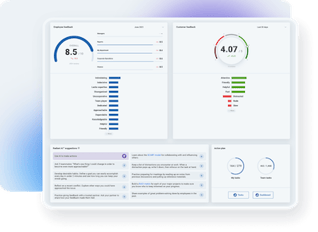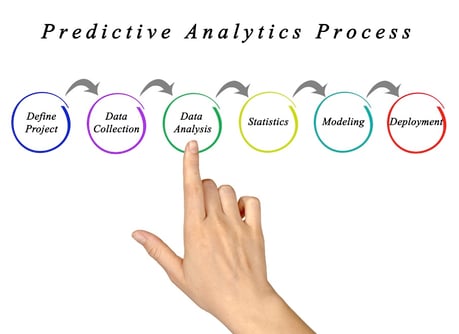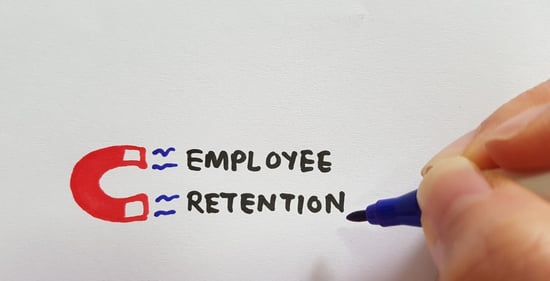
Employee Retention Prediction: How Predictive Analytics Reduces Turnover
Deloitte’s 2024 Global Human Capital Trends report found that while 79% of business leaders believe their organization has a responsibility to create value for workers as human beings, only 43% of employees feel their organization has left them better off than when they started—highlighting an ongoing gap between leadership priorities and actual employee experience.
TABLE OF CONTENTS
loading...
What does this mean for the modern business? Employee retention and turnover rates are the statistics that business leaders see when engagement becomes a problem. They also endure the costs of finding, hiring, and retraining skilled personnel, which puts further strain on the work environment. Businesses playing catchup with their engagement need a way to predict their employees’ feelings of low agency, rather than merely react to it.
Since employee retention involves numerous factors that are difficult to predict or strategically change, companies are turning to workforce retention analytics software to fill these gaps. Predictive analytics for employee turnover uses advanced AI and machine learning to identify trends in employee behavior and create strategies for reducing turnover risk.
Businesses equipped with the right workforce analytics can do more than repair a lack of engagement – they can become a business with a reputation for engaging (and thus, retaining) the skilled workers that drive their bottom line.
Since employee retention involves numerous factors that are difficult to predict or strategically change, companies are turning to workforce retention analytics software to fill these gaps. Predictive analytics for employee turnover uses advanced AI and machine learning to identify trends in employee behavior and create strategies for reducing turnover risk.
Businesses equipped with the right workforce analytics can do more than repair a lack of engagement – they can become a business with a reputation for engaging (and thus, retaining) the skilled workers that drive their bottom line.
Common Challenges in Employee Retention
Gallup has gathered statistics on the post-pandemic workforce that every employer needs to know about. The highlights of their 2024 poll include these foreboding numbers:
- 51% of employees are actively looking for different employment
- 30% of employees feel connected to their company’s mission/purpose, a record low
This means that half of your workforce is likely looking for other jobs, turning what should be your most valuable asset into your HR department’s greatest liability.
When asked why they were dissatisfied with their jobs, these employees offered many complaints that could easily become strategic insights for businesses that value employee retention. The qualities they cited related even more to the employee experience than to the pay and benefits they received.
For instance, 40% of these employees cited reasons related to “engagement and culture” when asked why they left their previous job, including a lack of career opportunities, unrealistic job expectations, feeling like their skills were unwanted or unneeded, and feeling like they weren’t being respected. Comparatively, only 19% of employees cited their pay as their primary reason for leaving.
As these numbers suggest, the employee experience is more than twice as important as money when gauging whether workers voluntarily leave. Of course, employees don’t always leave voluntarily – managers sometimes let them go, also known as “involuntary turnover.” This is a different statistic motivated by different factors, but it’s still important to examine in the context of a business’s work culture. Retention rate per manager, or the number of workers who remain employed with individual managers vs others, is another metric businesses should use to examine their employee turnover rates.
Another way to look at turnover is to consider the “employee lifecycle” as a multi-step process that follows an employee through their whole relationship with a company, starting with the recruiting process. Few employees stick around forever, so the goal of any human resources strategy equipped with employee data should be to prolong the cycle as long as possible. As such, it is important for HR managers to be aware of the criteria that can lead to high turnover rates, including:
- Low workplace flexibility, particularly concerning remote employment options
- Unsustainable employment expectations
- Lack of career opportunities or advancement
- Uncaring leadership
- Insufficient compensation
- Feeling unneeded, unrewarded, or disrespected in the workplace
This is not a comprehensive list, but HR managers know that these criteria cause a serious drain on human capital for modern businesses. They’re also the factors that workforce analytics software works to address.
The Value of Employee Retention Analytics
Predictive analytics have become a fixture of many HR departments. As of 2024, over 65% of organizations are using workforce analytics solutions to enhance employee engagement, productivity, and decision-making—marking significant growth compared to just a few years ago. However, despite the widespread adoption, many businesses still struggle to translate the data into meaningful insights for leadership, often leaving gaps between the analytics collected and actionable strategies.
What this means is that business leaders know the value of investing in analytics without always knowing how to choose the system that produces actionable results for their problem areas, such as their high turnover rates.
This isn’t surprising considering that workforce analytics systems can provide so many functions that shopping for specific models can be difficult. But what versatile systems have in common is an ability to identify and collect data that makes actionable strategies for higher employee retention more viable than conventional methods - especially when supported by targeted employee retention data analysis.
For example, consider the question of employee engagement from the point of view of the workers. They want to be fulfilled in their position, to have advancement opportunities, and to feel valued by management. For the business or team leader, low engagement can be difficult to notice until it’s too late due to how intangible these factors can seem. But for a workforce analytics program, low engagement can be seen earlier and more clearly through identifiable statistics, such as:
- Employee NPS
- Employee absenteeism
- Employee retention rate
- Employee turnover rate
- Employee Learning and Development
- Employee satisfaction
- Vacation day usage
Analytics that can collate this data over time can help businesses spot their weaknesses and reinforce their strengths. You should know that losing an employee is costly, often requiring as much as two times the worker’s annual salary to recoup the costs of finding, hiring, training, and developing a new worker at the same skill level. So identifying these risk factors to employee engagement is critical to retaining the skilled workers you have already trained and developed.
But how can businesses measure employee engagement? Asking the right questions can help team leaders understand how employees think about their position, whether they think their skills are valued, whether they trust their coworkers, and more. These factors are critical to engagement.
Yet, asking questions can only take a business so far. To understand not only “whether” employees feel engaged but why they do or don’t, businesses now employ predictive analytics to find the risk factors for low engagement before they start impacting their turnover rates.
Using Data Analysis to Predict Employee Turnover
To understand high turnover rates, businesses have always turned to data. The problem in the past has been keeping the analyses of that data accurate and consistent. Workforce analytics software collects and analyzes data from many useful sources, including:
- Historical trends
- Employee databases
- Employee engagement surveys
- Performance evaluations
- Industry benchmarks
- Time-tracking systems
- Current market predictions
The system builds an analytics model from the framework of this data. Versatile systems can even search within your business to identify employees that fit the profile of those who tend to leave using various factors, including job performance, satisfaction, and tenure.
The analytics can then be fine-tuned for more insightful readouts. For instance, the software may use “cross-validation” to assess the performance of its analytics model against the data. The system can accomplish a few key things for businesses concerned about their turnover:
- Using the finished model, recruiters can track applicants and refine their list of candidates for specific positions, avoiding risk factors for turnover.
- Managers can identify the pain points of their current employees and try to improve their engagement, such as by adopting a more encouraging attitude in the workplace, making advancement opportunities clearer, or investing in remote work infrastructure.
- Top leaders can analyze the business comprehensively with a focus on analytics. They observe which managers are more promising long-term investments according to the models, and change company procedures to mitigate turnover risk factors.
Data-Driven Retention Strategies That Work
Employee analytics allow companies to develop strategies, make smarter decisions, and save costs by improving engagement. But how can data be used to encourage employees to stay in their current position? It all comes down to the employee experience.
Data-driven insights allow managers to identify what their employees want from their position, including advancement opportunities, remote work opportunities, realistic expectations for their work, and to feel like their skills are needed as they “upskill” in their field. Analytics help businesses guide their investments toward strategies that tailor these factors to employee expectations.
For example, your HR team can lead a focused intervention on certain risk factors, such as a lack of employee appreciation or a lack of socialization in the workplace. On the other hand, top management can use the data to enact more global strategies, such as by using company resources to increase employee skill training via a company LMS.
The benefits of workforce analytics extend beyond these points. These examples merely demonstrate how data-backed solutions can be crafted to mitigate turnover risk factors in your business. Without the analytics examining your unique situation, strategies are little more than guesses.
Workforce Retention Analytics for Hiring
Predictive analytics in employee retention are useful even before employees are hired. HR departments can use analytics to track risk factors and assign “risk levels” to potential employees. This informs their decision on who to hire since employees with a high predicted turnover rate could be twice as costly as employees with a lower rate.
Once managers understand these predictions, hiring smarter and retaining longer becomes a matter of keeping the data refined and updated, which modern predictive analytics do to stay ahead of the trends.
To do this, predictive analytics software solutions can be customized to work within a business’s existing HR infrastructure rather than replace it. Data-driven approaches can impact every part of the employee lifecycle, from the interview to the exit. So the more robust your pre-hire analytics, the more success you can predict before even paying for the training.
Employee retention relies heavily on employee engagement, a complex metric with many factors, including your managerial strategies, upskilling opportunities, and payscale. Many HR departments struggle to quantify it in a way that helps leadership craft useful strategies to improve retention.
Predictive analytics offer numerous ways for companies to predict the risk factors that cause high employee turnover rates. Notably, the models created by workforce analytics software can be used to predict risk factors for turnover even during the hiring process, allowing businesses to hire talent that will be an investment for them instead of a delayed cost. These systems may also offer features such as customizable resource creation for different HR needs, individualized action plans for your business, and individual manager coaching.
Predictive analytics in employee retention represent more than the most competitive way that businesses can retain employees. They deliver solutions that unify individual workflows, taking into account unique risk factors and incorporating a broader range of data sources than human managers ever could. Ask your prospective vendor about how their software integrates with existing company infrastructure to stop the most preventable drain on employee retention the only way that a modern business can: by predicting it.
Once managers understand these predictions, hiring smarter and retaining longer becomes a matter of keeping the data refined and updated, which modern predictive analytics do to stay ahead of the trends.
To do this, predictive analytics software solutions can be customized to work within a business’s existing HR infrastructure rather than replace it. Data-driven approaches can impact every part of the employee lifecycle, from the interview to the exit. So the more robust your pre-hire analytics, the more success you can predict before even paying for the training.
Implementing Predictive Turnover Analysis in Your Business
Employee retention relies heavily on employee engagement, a complex metric with many factors, including your managerial strategies, upskilling opportunities, and payscale. Many HR departments struggle to quantify it in a way that helps leadership craft useful strategies to improve retention.
Predictive analytics offer numerous ways for companies to predict the risk factors that cause high employee turnover rates. Notably, the models created by workforce analytics software can be used to predict risk factors for turnover even during the hiring process, allowing businesses to hire talent that will be an investment for them instead of a delayed cost. These systems may also offer features such as customizable resource creation for different HR needs, individualized action plans for your business, and individual manager coaching.
Predictive analytics in employee retention represent more than the most competitive way that businesses can retain employees. They deliver solutions that unify individual workflows, taking into account unique risk factors and incorporating a broader range of data sources than human managers ever could. Ask your prospective vendor about how their software integrates with existing company infrastructure to stop the most preventable drain on employee retention the only way that a modern business can: by predicting it.
See it in action, request an employee retention software demo today.
Editors note: this blog was originally published in December 2023 and has been updated for accuracy and comprehensiveness.









